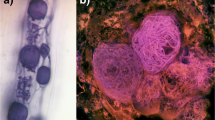Summary
Sheathing mycorrhizal fungi have been shown to possess phosphatase enzymes which can hydrolyse inositol hexaphosphate. In a range of mycorrhizal fungi, this activity was often greater than in two common decomposer basidiomycetes. Mycorrhizal birch and pine roots both produce phosphatases. In birch production is inversely related to the inorganic phosphorus concentration in the growth medium. Mycorrhizas reduce phosphatase activity compared with non-mycorrhizal plants.
Phosphatase production by basidiomycete fungi in liquid culture is independent of P in the medium. Saprophytic basidiomycetes tend to incorporate hydrolysed phosphate into their biomass. In contrast mycorrhizal fungi release more into solution than they absorb. The significance of this difference in relation to the supply of nutrients to plants is discussed.
Similar content being viewed by others
References
Alexander I J and Hardy K 1981 Surface phosphatase activity of Sitka spruce mycorrhizas from a Serpentine site. Soil Biol. Biochem. 13, 301–305.
Bartlett E M and Lewis D H 1973 Surface phosphatase activity of mycorrhizal roots of beech. Soil Biol. Biochem. 5, 249–257.
Beever R E and Burns D J W 1980 Phosphorus uptake, storage and utilization by fungi. Adv. Bot. Res. 8, 127–219.
Calleja M, Moussin D, Lecouvreur B and D'Auzac J 1980 Influence de la carence phosphatée sur les activités phosphatases acides de trois champignon mycorrhiziens:Hebeloma edurum Metrod.,Suillus granulatus (L. ex Fr.) O Kuntze etPisolithus tinctorius (Pers.) Coker et Couch. Physiol. Vég. 18, 489–504.
Casida L E Jr. 1959 Phosphatase activity of some common soil fungi. Soil Sci. 87, 305–310.
Chhonkar P K and Subba-Rao N S 1967 Phosphate solubilization by fungi associated with legume root nodules. Can. J. Microbiol. 13, 749–753.
Gadgil R L and Gadgil P D 1971 Mycorrhiza and litter decomposition. Nature London 233, 133.
Gadgil R L and Gadgil P D 1975 Suppression of litter decomposition by mycorrhizal roots ofPinus radiata. N. Z. Jl. For. Sci. 5, 33–41.
Giltrap N J 1982 Production of polyphenol oxidases by ectomycorrhizal fungi with special reference toLactarius spp. Trans. Br. Mycol. Soc. 78, 75–81.
Harrison A F and Pearce T 1979 Seasonal variation of phosphatase activity in woodland soils. Soil Biol. Biochem. 11, 405–410.
Hayman D J and Mosse B 1972 The role of vesicular-arbuscular mycorrhiza in the removal of phosphorus from soil by plant roots. Rev. Ecol. Biol. Sol. 11, 463–470.
Hewitt E J 1952 Sand and water culture methods used in the study of plant nutrition. Tech. Commun. Commonw. Bur. Hort. Plantn. Crops No. 22, 241 p.
Ho I and Zak B 1979 Acid phosphatase activity of six ectomycorrhizal fungi. Can. J. Bot. 57, 1203–1205.
Hoffman G 1968 Eine photometrische Methode zur Bestimmung der Phosphatase-Aktivität in Böden. Z. Pflanzenernaehr Dueng. Bodenkd. 118, 161–172.
John M K 1970 Colorimetric determination of phosphorus in soil and plant materials with ascorbic acid. Soil Sci. 109, 214–220.
Katznelson H, Peterson E A and Rouatt J W 1962 Phosphate-disolving microorganisms on seed and in the root zone of plants. Can. J. Bot. 40, 1041–1180.
Martin N K 1973 The influence of rhizosphere microflora on the availability of32p-myoinositol hexaphosphate phosphorus to wheat. Soil Biol. Biochem. 5, 473–483.
Mason P A, Dighton J, Last F T and Wilson J 1983 Procedure for establishing sheathing mycorrhizas on tree seedlings. For. Ecol. Manage. 5, 47–53.
Morrison T M 1962 Absorption of phosphorus from soils by mycorrhizal plants. New Phytol. 61, 10–20.
Saxena S N 1964 Phytase activity of plant roots. J. Exp. Bot. 15, 654–658.
Shieh T R and Ware J H 1968 Survey of microorganisms for the production of extracellular phytase. Appl. Microbiol. 16, 1348–1351.
Theodorou C 1967 Inositol phosphates in needles ofPinus radiata D. Don and the phytase activity of mycorrhizal fungi. Trans. 9th Int. Cong. Soil Sci. 3, 483–490.
Theodorou C 1971 The phytase activity of the mycorrhizal fungusRhizopogon luteolus. Soil Biol. Biochem. 3, 89–90.
Woolhouse H W 1969 Differences in the properties of the acid phosphatases of plant roots and their significance in the evolution of edaphic ecotypes.In Ecological Aspects of the Mineral Nutrition of Plants. Ed. T H Rorison. Blackwell, Oxford. pp 357–380.
Author information
Authors and Affiliations
Rights and permissions
About this article
Cite this article
Dighton, J. Phosphatase production by mycorrhizal fungi. Plant Soil 71, 455–462 (1983). https://doi.org/10.1007/BF02182686
Issue Date:
DOI: https://doi.org/10.1007/BF02182686




